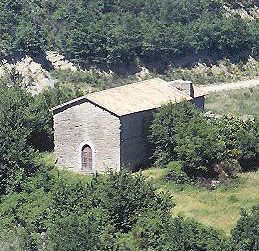Dai ruderi di una chiesa risalente alla fine dell’XI secolo e di un tempietto pagano i francescani ricostruiscono un piccolo convento ed il loro tempio.
Oggi rimane in piedi la chiesa, mentre dai pochi resti del monastero è possibile solo intuire le dimensioni e lo stile architettonico. L’interno dell’oratorio è un unico ambiente, a sviluppo longitudinale allungato e tetto a capriate. Caprignone, risponde totalmente ai canoni stilistici francescani, l’assenza di decorazioni, lo spazio delimitato da superfici nude, l’impiego di materiali locali rivelano la totale adesione dell’edificio sia agli ideali di essenzialità propri dell’Ordine, sia alle tradizionali tecniche di costruzione del luogo.
From the ruins of a church dating back to the end of the 11th century and a small pagan temple the Franciscans build a small convent and their temple.
Today the church remains, while from the few traces left of the monastery we can only guess the dimensions and the architectonic style. The internal part of the oratory is a unique environment, a longitudinal development and a rafter roof. Caprignone is in perfect line with the Franciscan stylish canons, the absence of decorations, the space delimitated by nude superficies, the use of local materials are revealing the total adhesion of the building to the proper ideals of essentiality of the Order, as well as to the traditional techniques of construction of the place.
From the ruins of a church dating back to the end of the 11th century and a small pagan temple the Franciscans build a small convent and their temple.
Today the church remains, while from the few traces left of the monastery we can only guess the dimensions and the architectonic style. The internal part of the oratory is a unique environment, a longitudinal development and a rafter roof. Caprignone is in perfect line with the Franciscan stylish canons, the absence of decorations, the space delimitated by nude superficies, the use of local materials are revealing the total adhesion of the building to the proper ideals of essentiality of the Order, as well as to the traditional techniques of construction of the place.
From the ruins of a church dating back to the end of the 11th century and a small pagan temple the Franciscans build a small convent and their temple.
Today the church remains, while from the few traces left of the monastery we can only guess the dimensions and the architectonic style. The internal part of the oratory is a unique environment, a longitudinal development and a rafter roof. Caprignone is in perfect line with the Franciscan stylish canons, the absence of decorations, the space delimitated by nude superficies, the use of local materials are revealing the total adhesion of the building to the proper ideals of essentiality of the Order, as well as to the traditional techniques of construction of the place.
From the ruins of a church dating back to the end of the 11th century and a small pagan temple the Franciscans build a small convent and their temple.
Today the church remains, while from the few traces left of the monastery we can only guess the dimensions and the architectonic style. The internal part of the oratory is a unique environment, a longitudinal development and a rafter roof. Caprignone is in perfect line with the Franciscan stylish canons, the absence of decorations, the space delimitated by nude superficies, the use of local materials are revealing the total adhesion of the building to the proper ideals of essentiality of the Order, as well as to the traditional techniques of construction of the place.


Comment (0)